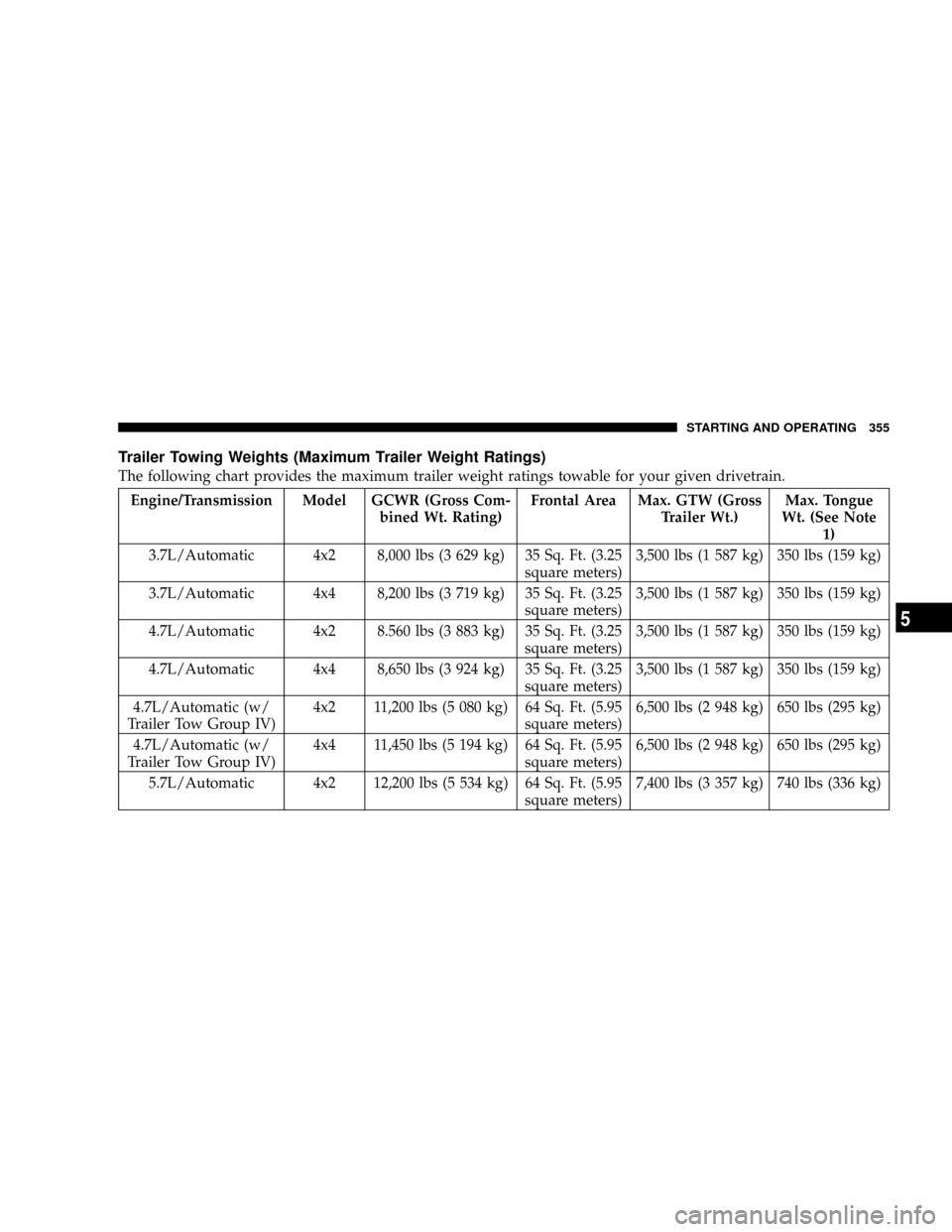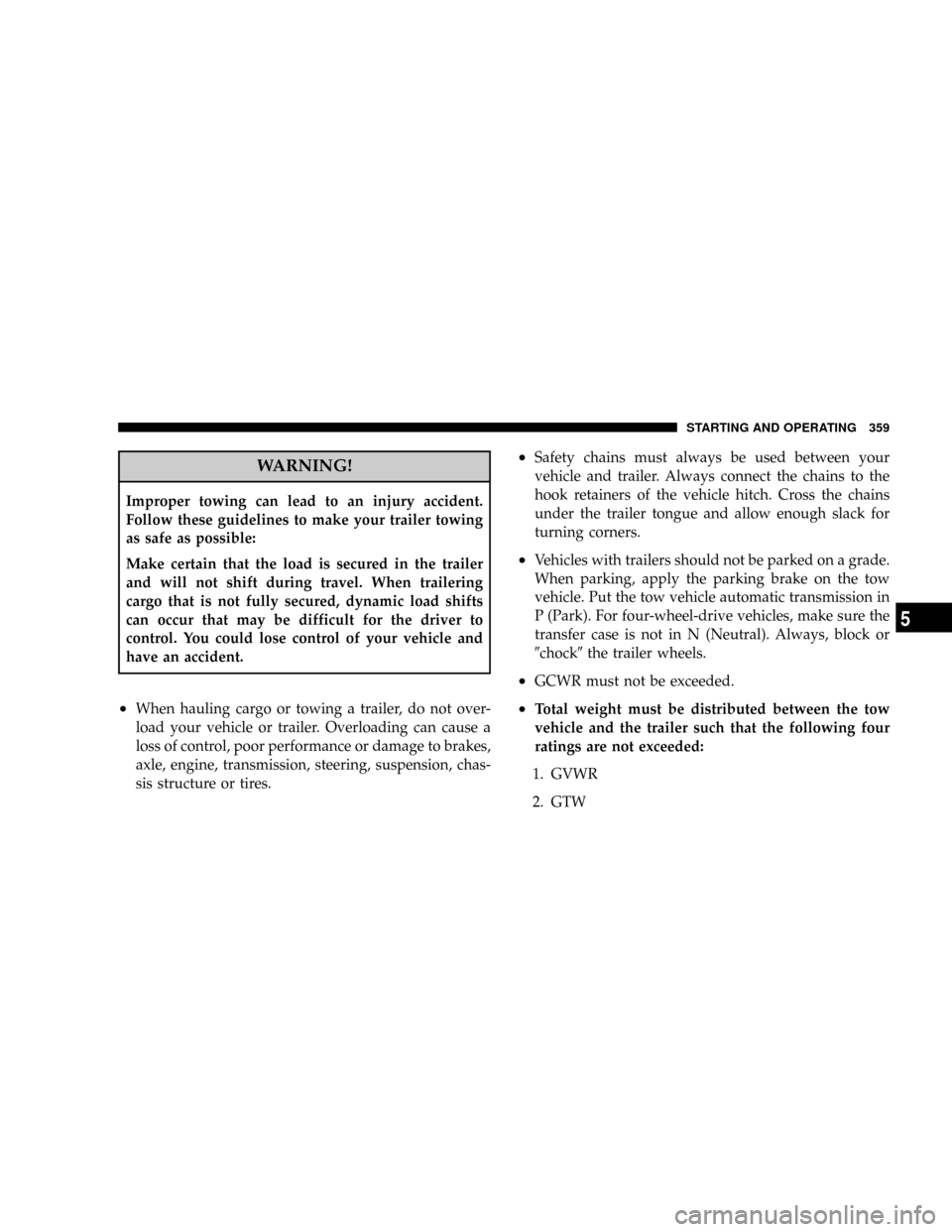Page 355 of 490

Trailer Towing Weights (Maximum Trailer Weight Ratings)
The following chart provides the maximum trailer weight ratings towable for your given drivetrain.
Engine/Transmission Model GCWR (Gross Com-
bined Wt. Rating)Frontal Area Max. GTW (Gross
Trailer Wt.)Max. Tongue
Wt. (See Note
1)
3.7L/Automatic 4x2 8,000 lbs (3 629 kg) 35 Sq. Ft. (3.25
square meters)3,500 lbs (1 587 kg) 350 lbs (159 kg)
3.7L/Automatic 4x4 8,200 lbs (3 719 kg) 35 Sq. Ft. (3.25
square meters)3,500 lbs (1 587 kg) 350 lbs (159 kg)
4.7L/Automatic 4x2 8.560 lbs (3 883 kg) 35 Sq. Ft. (3.25
square meters)3,500 lbs (1 587 kg) 350 lbs (159 kg)
4.7L/Automatic 4x4 8,650 lbs (3 924 kg) 35 Sq. Ft. (3.25
square meters)3,500 lbs (1 587 kg) 350 lbs (159 kg)
4.7L/Automatic (w/
Trailer Tow Group IV)4x2 11,200 lbs (5 080 kg) 64 Sq. Ft. (5.95
square meters)6,500 lbs (2 948 kg) 650 lbs (295 kg)
4.7L/Automatic (w/
Trailer Tow Group IV)4x4 11,450 lbs (5 194 kg) 64 Sq. Ft. (5.95
square meters)6,500 lbs (2 948 kg) 650 lbs (295 kg)
5.7L/Automatic 4x2 12,200 lbs (5 534 kg) 64 Sq. Ft. (5.95
square meters)7,400 lbs (3 357 kg) 740 lbs (336 kg)
STARTING AND OPERATING 355
5
Page 359 of 490

WARNING!
Improper towing can lead to an injury accident.
Follow these guidelines to make your trailer towing
as safe as possible:
Make certain that the load is secured in the trailer
and will not shift during travel. When trailering
cargo that is not fully secured, dynamic load shifts
can occur that may be difficult for the driver to
control. You could lose control of your vehicle and
have an accident.
²When hauling cargo or towing a trailer, do not over-
load your vehicle or trailer. Overloading can cause a
loss of control, poor performance or damage to brakes,
axle, engine, transmission, steering, suspension, chas-
sis structure or tires.
²Safety chains must always be used between your
vehicle and trailer. Always connect the chains to the
hook retainers of the vehicle hitch. Cross the chains
under the trailer tongue and allow enough slack for
turning corners.
²Vehicles with trailers should not be parked on a grade.
When parking, apply the parking brake on the tow
vehicle. Put the tow vehicle automatic transmission in
P (Park). For four-wheel-drive vehicles, make sure the
transfer case is not in N (Neutral). Always, block or
9chock9the trailer wheels.
²GCWR must not be exceeded.
²Total weight must be distributed between the tow
vehicle and the trailer such that the following four
ratings are not exceeded:
1. GVWR
2. GTW
STARTING AND OPERATING 359
5
Page 363 of 490

Towing Tips Ð Automatic Transmission
The ªDº range can be selected when towing. However, if
frequent shifting occurs while in this range, the ºTow/
Haulº mode (if equipped) or a lower gear range should
be selected.
NOTE:Using the ºTow/Haulº mode (if equipped) or a
lower gear range while operating the vehicle under
heavy operating conditions will improve performance
and extend transmission life by reducing excessive shift-
ing and heat build up. This action will also provide better
engine braking.
The automatic transmission fluid and filter should be
changed if you REGULARLY tow a trailer for more than
45 minutes of continuous operation. Refer to the ªMain-
tenance Scheduleº in Section 8 of this manual for trans-
mission fluid change intervals.
NOTE:Check the automatic transmission fluid level
before towing.
Towing Tips Ð Electronic Speed Control (If
Equipped)
þ
Don't use in hilly terrain or with heavy loads.
þWhen using the speed control, if you experience speed
drops greater than 10 mph (16 km/h), disengage until
you can get back to cruising speed.
þUse speed control in flat terrain and with light loads to
maximize fuel efficiency.
Towing Tips Ð Cooling System
To reduce potential for engine and transmission over-
heating, take the following actions:
þCity Driving
When stopped for short periods of time, put transmission
in N (Neutral) and increase engine idle speed.
þHighway Driving
Reduce speed.
STARTING AND OPERATING 363
5
Page 365 of 490
Shifting Into Neutral (N)
Use the following procedure to prepare your vehicle for
recreational towing.
CAUTION!
It is necessary to follow these steps to be certain that
the transfer case is fully in N (Neutral) before recre-
ational towing to prevent damage to internal parts.
1. Depress brake pedal.
2. Turn the ignition key ON, engine off.
3. Shift transmission into N (Neutral).
4. Shift transfer case into N (Neutral).
Hold down N (Neutral) ªpinº switch (with a pen, etc.) for
4 seconds until the LED lamp by the switch starts to blink
indicating shift in progress. Lamp will stop blinking (stayon solid) when Neutral shift is complete. A ª4WD
SYSTEM IN NEUTRALº message will display on the
EVIC (Electronic Vehicle Information Center). Refer to
ªElectronic Vehicle Information Center (EVIC)º in Sec-
tion 4 of this manual.
Neutral Switch
STARTING AND OPERATING 365
5
Page 366 of 490
5. Start engine.
6. Shift transmission into D (Drive).
7. Release brake pedal and ensure that there is no vehicle
movement.
8. Shut the engine off.
9. Shift transmission into P (Park).
10. Place the ignition key in the OFF position, and
remove key.
11. Apply parking brake.
12. Attach vehicle to the tow vehicle with tow bar.
13. Release parking brake.CAUTION!
Transmission damage may occur if the transmission
is shifted into P (Park) with the transfer case in N
(Neutral) and the engine running. With the transfer
case in N (Neutral) ensure that the engine is OFF
prior to shifting the transmission into P (Park) (refer
to steps7±8above).
366 STARTING AND OPERATING
Page 367 of 490
Shifting Out Of Neutral (N)
Use the following procedure to prepare your vehicle for
normal usage.
1. Depress brake pedal.
2. Turn the ignition key ON, engine off.
3. Shift transmission into N (Neutral).
4. Shift transfer case out of N (Neutral).
Hold down N (Neutral) ªpinº switch (with a pen, etc.) for
4 seconds until the LED lamp by the switch starts to blink
indicating shift in progress. Lamp will stop blinking (go
out) when shift is complete. The ª4WD SYSTEM IN
NEUTRALº message will no longer be displayed on the
EVIC (Electronic Vehicle Information Center). Refer to
ªElectronic Vehicle Information Center (EVIC)º in Sec-
tion 4 of this manual.5. Shift transmission into P (Park).
6. Start the engine.
7. Shift transmission into D (Drive).
NOTE:
When shifting out of transfer case N (Neutral),
turning the engine OFF may be required to avoid gear clash.
Neutral Switch
STARTING AND OPERATING 367
5
Page 369 of 490
WHAT TO DO IN EMERGENCIES
CONTENTS
mHazard Warning Flashers.................370
mIf Your Engine Overheats.................371
mJacking And Tire Changing................372
NJack Location........................372
NSpare Tire Stowage....................373
NSpare Tire Removal....................373
NPreparations For Jacking................374NJacking Instructions....................375
mJump Starting.........................378
mEmergency Tow Hooks Ð If Equipped........381
mTowing A Disabled Vehicle................382
N2WD Models Only....................382
N4WD Models Only....................382
6
Page 371 of 490

IF YOUR ENGINE OVERHEATS
In any of the following situations, you can reduce the
potential for overheating by taking the appropriate ac-
tion.
²On the highways Ð Slow down.
²In city traffic Ð While stopped, put transmission in N
(Neutral), but do not increase engine idle speed.
NOTE:There are steps that you can take to slow down
an impending overheat condition. If your air conditioner
is on, turn it off. The air conditioning system adds heat to
the engine cooling system and turning off the A/C
removes this heat. You can also turn the Temperature
Control to maximum heat, the Mode Control to floor, and
the Fan Control to High. This allows the heater core to act
as a supplement to the radiator and aids in removing heat
from the engine cooling system.
CAUTION!
Driving with a hot cooling system could damage
your vehicle. If the temperature gauge reads ªHº,
pull over and stop the vehicle. Idle the vehicle with
the air conditioner turned off until the pointer drops
back into the normal range. If the pointer remains on
the ªHº, and you hear continuous chimes, turn the
engine off immediately, and call for service.
WHAT TO DO IN EMERGENCIES 371
6